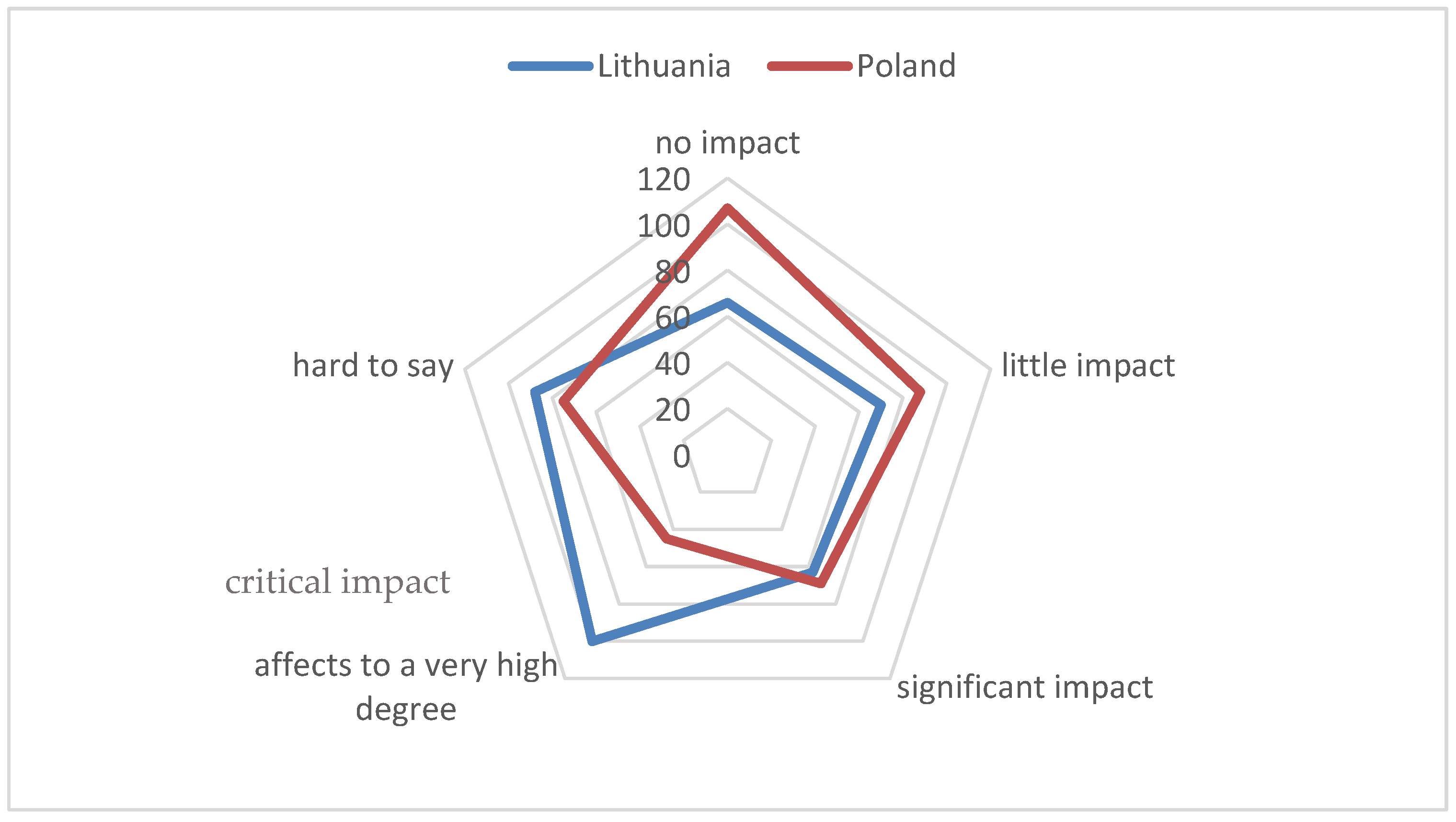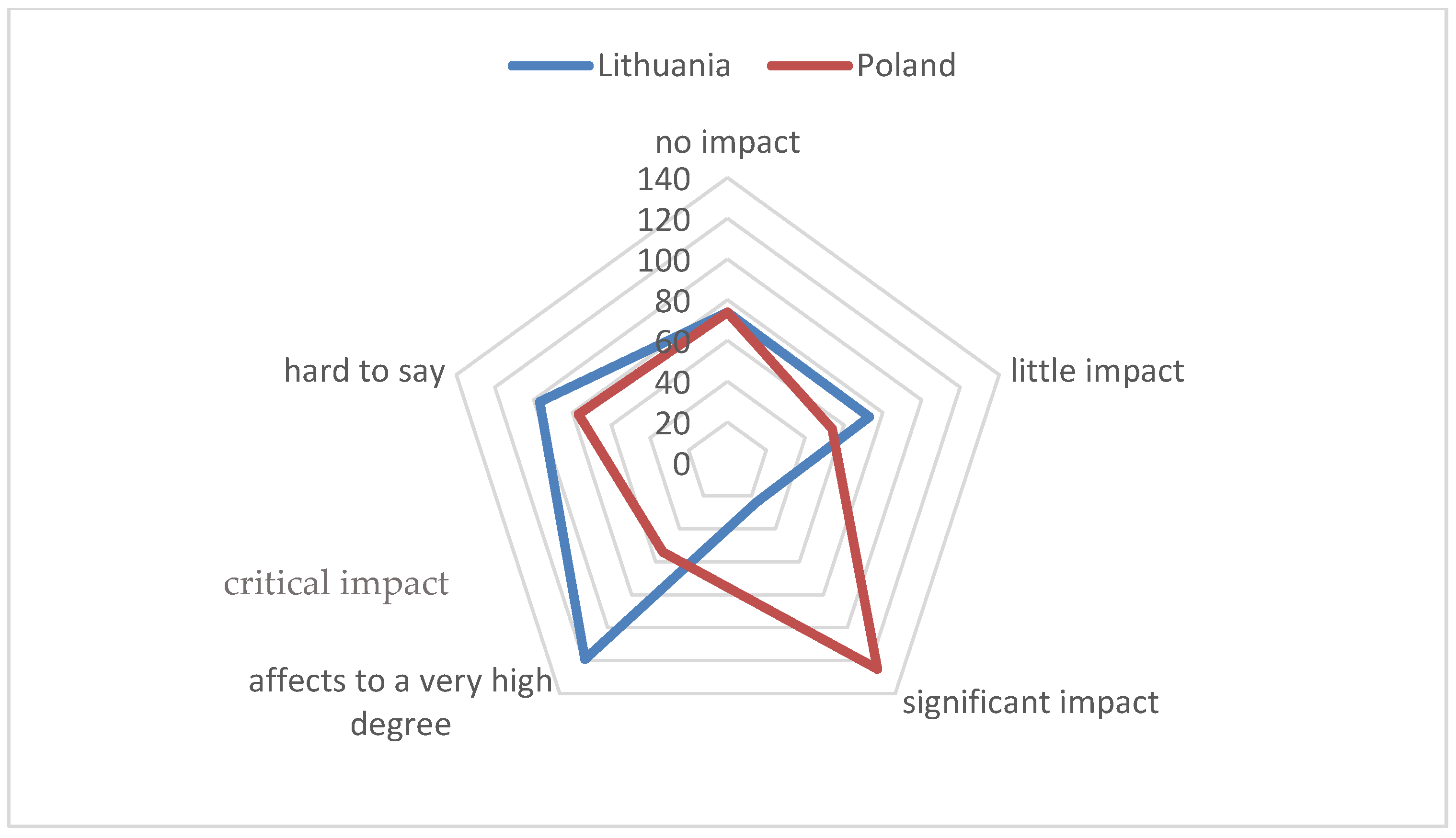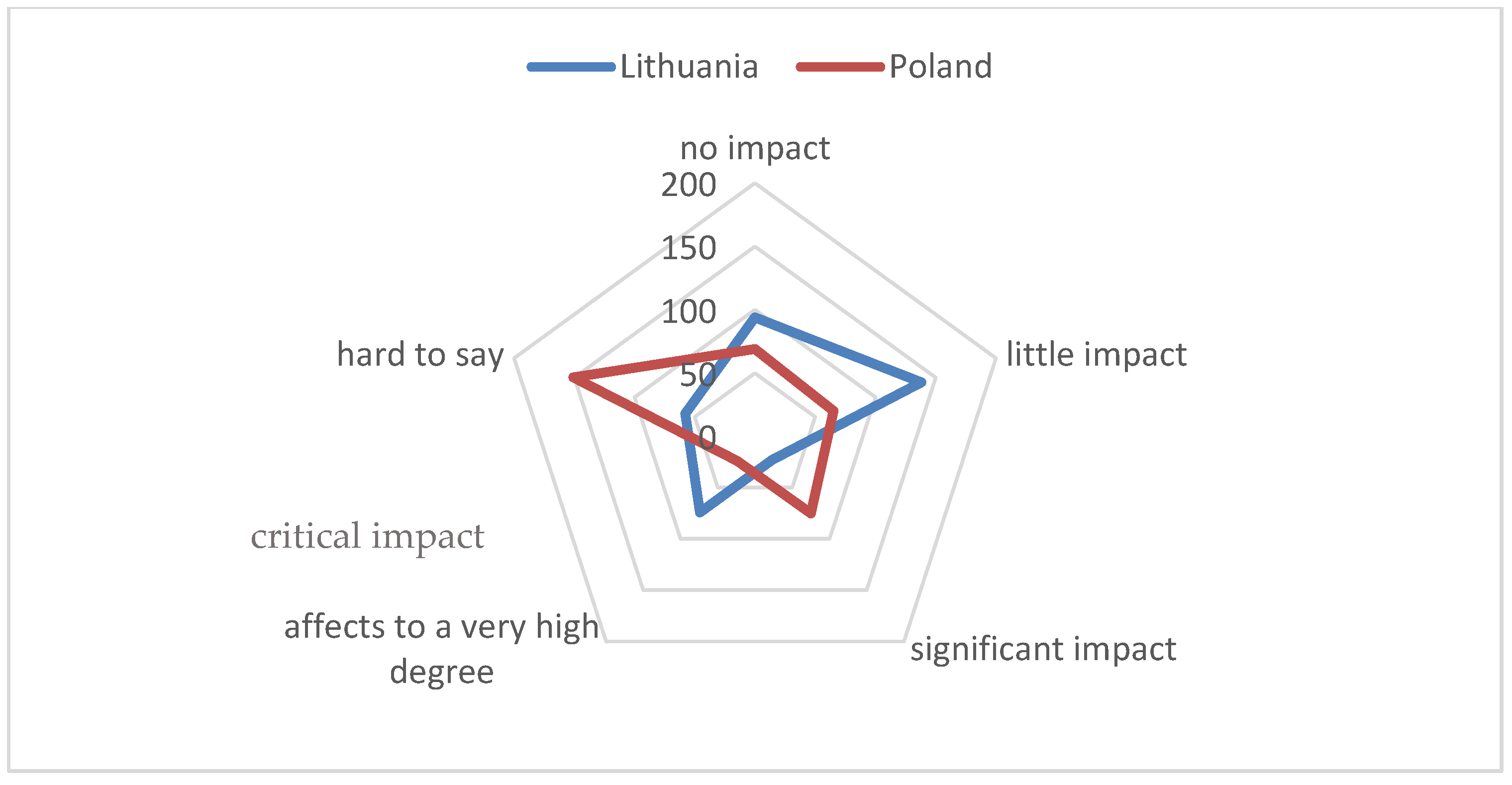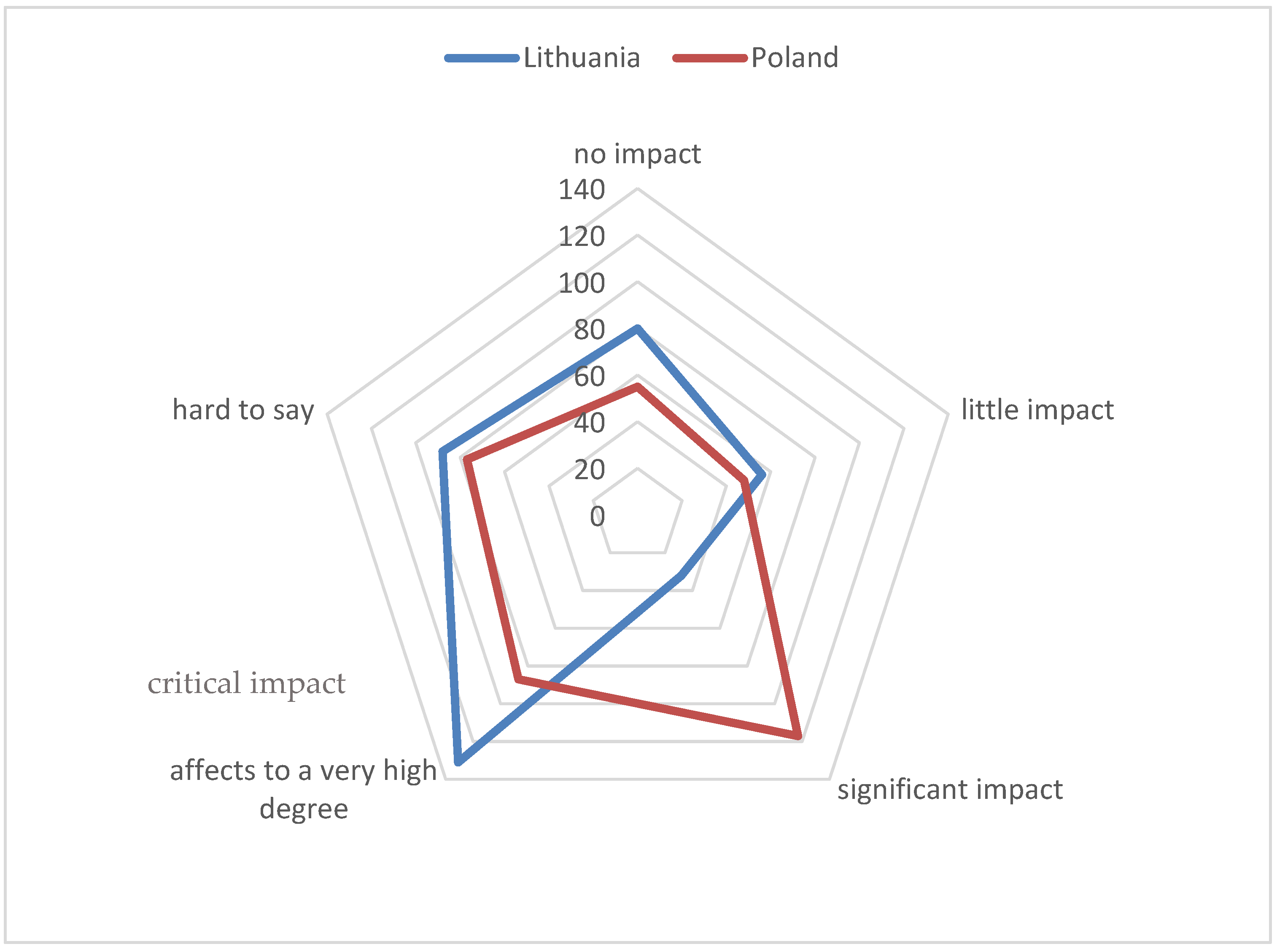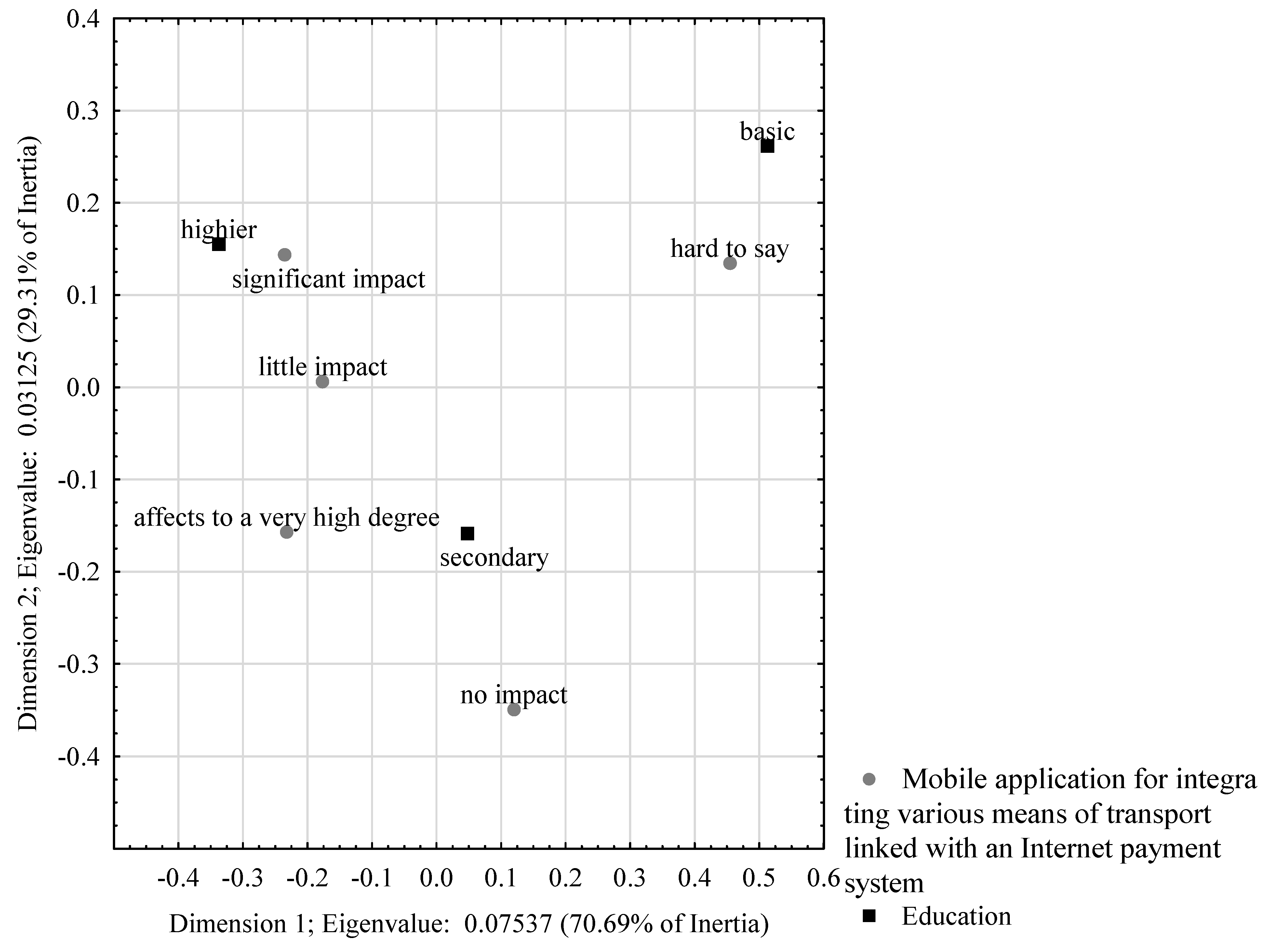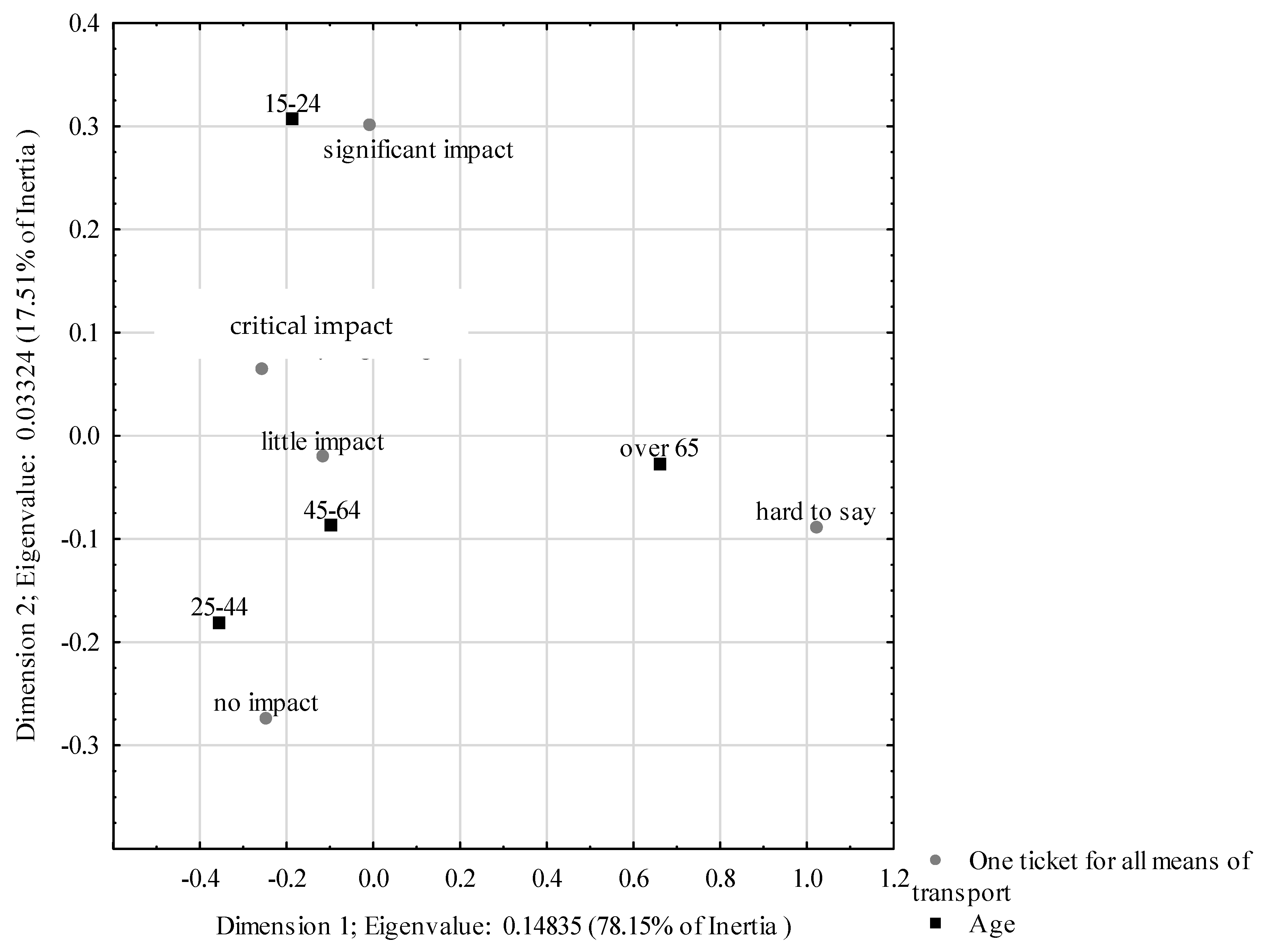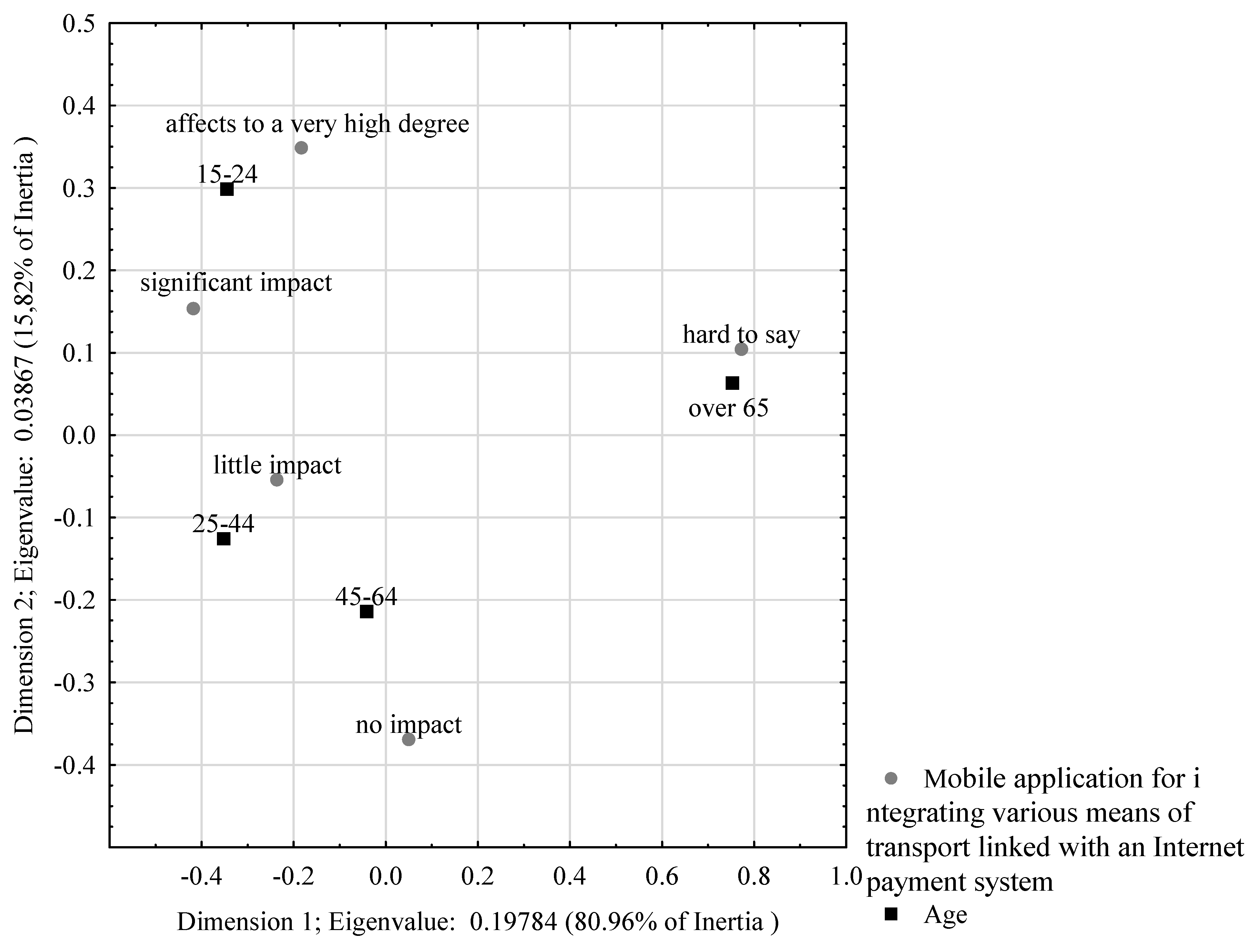1. Introduction
Socio-economic changes in rural areas influenced the scale and structure of the needs of the population, including those related to transport. Rural areas are characterised by scattered buildings and low population density. Some members of the population living in rural areas pursue their educational needs and are professionally active outside their place of residence. In rural regions, the population’s health or shopping needs often remain unmet, or the possibility of meeting those needs is limited. The above-mentioned facts are important prerequisites for the residents of rural areas to look for opportunities to meet their needs in other regions, which requires movement. Mobility issues are among many problems faced by residents of rural areas. A relatively large amount of research is devoted to mobility in urban areas. Smart mobility is part of the smart city concept and concerns the sustainable movement of people. With the support of new technologies, smart cities are transformed into smart communities [
1]. It is a new trend concerning the organisation of space and applies mainly to cities (smart city); however, intelligent mobility solutions can also be introduced in rural areas. Bosworth et al. [
2] claim that rural development should be looked at through the lens of a “smart village”. Such a solution shapes a sustainable place to live, taking into account social, economic and environmental contexts. The need to implement the promotion of mobility into the development policy of rural areas is also emphasised [
3].
Transport strategies have so far focused primarily on urban mobility, based on the assumption that technology advances will shift to rural areas [
2]. Such a scenario seems to be too optimistic because the disproportions in the socio-economic development of rural areas do not change much in terms of public transport accessibility [
4]. Rural areas require new technologies to solve issues related to transport [
2]. Local public transport systems operating in rural areas are forced to adopt such innovative strategies due to demographic changes.
The problems of introducing innovative solutions to improve the mobility and accessibility of rural areas, which are usually also peripheral, have been discussed in the scientific literature. The literature review showed that there is a research gap and that research on mobility issues and innovations is mainly of a fragmented nature. There is a distinct lack of comparative research on this issue in regions with similar functions. The presented research expands the current knowledge on mobility in rural areas that are characterised by special natural values. The study concerns the mobility of the inhabitants of two regions: the area of the Bialowieza Forest in Poland and the region of Druskininkai in Lithuania. Both areas are rich in natural and cultural values, which, due to the limitations related to environmental protection (including the location of industry), require the implementation of innovative, environmentally-friendly transport solutions. The above point of view is confirmed by the research conducted by Porru et al. [
5], according to which the use of the internet (IT) has proved to be an appropriate response to the challenges related to mobility in rural areas and has led to the development of the concept of “smart land”. The concept concerns using new, digital technologies in rural management. Innovative mobility concepts emerge as technology advances, resulting in improved living conditions for rural residents. The growing importance of digital technologies in improving rural mobility is highlighted in a study by Milbourne and Kitchen [
6]. The issue in question is important for economic reasons, as it is about using the potential to develop the local economy, and for social reasons, since the improvement of mobility is one of the forms of preventing marginalisation and social exclusion of a significant group of the population.
The study aims to identify the specifics of innovative mobility solutions expected by rural region inhabitants based on the example of selected regions in Lithuania and Poland. Addressing rural mobility in the context of innovative and sustainable solutions is a novel contribution to the research on this issue. This comparative approach, focusing on slightly different rural regions in two separate countries, should be considered new. Therefore, research results are both theoretical (innovation theory, sustainable rural development) and practical (selection of optimal environmentally-friendly mobility solutions).
2. The Issue of Mobility in Rural Areas in the Scientific Literature
An efficient transport system is a prerequisite for the development of any region. There is a shortage of public transport services in rural areas, which is due to many reasons, including demographic changes and an increase in private means of transport owned by households [
7]. The reasons for poor transport accessibility are far more complex than most researchers state. These problems can be discussed in regional (micro and macro), technological, cultural, social (e.g., in terms of social exclusion), financial, defence, political (as a tool of state policy) and environmental (analysing the impact of transport on the environment) contexts. The subject matter is extremely broad and complex, as pointed out by such scholars as Zhu et al. [
8].
The lack of or limited access to means of transport restricts access to educational institutions, the labour market or healthcare. Karen Lukas refers to such a situation as “transport poverty” [
9]. Transport plays a key role in mitigating rural youth migration and social exclusion [
10,
11]. Dahlberg and McKee [
12] interpret social exclusion as follows: “Social exclusion is a process that limits participation in society across life domains and is associated with poor quality of life”. Social exclusion is therefore inextricably linked to the quality of life, having a direct impact on its decline. According to the results of several studies, the residents of areas with better accessibility to transport are more integrated with the local community and are less likely to experience social exclusion [
9,
13,
14,
15]. Reducing social exclusion is an integral part of the transport policy defined for a provided region. The social aspect of transport accessibility is important because it is an element of improving the quality of life in rural areas. A well-organised transport system allows inhabitants to move around on a daily basis, contributes to integration with other regions, and, as a result, improves the attractiveness of rural areas as a place of residence. Poor transport accessibility is caused by dispersed settlement structures that make it difficult to introduce an efficient public transport system. Transport providers face decreasing demand and increasing costs for such services, limiting their range as a result [
16,
17]. In the world of today, mobility depends mainly on having a private car. According to Soder and Peer [
18], social inclusion and employment opportunities are severely limited for anyone who does not have a car. Berg and Ihlström [
14] point to the flexibility that a car provides, which is something that neither public transport nor car-sharing can offer. According to Vern and Taegen [
19], having your own car is a necessity due to the lack of public transport. Zhao and Yu [
20] point out that although owning a car is often the only alternative to public transport, less affluent members of the rural population also face difficulties in accessing this mode of transport. An individual who does not own a car faces an increased risk of social exclusion, especially if he or she is a senior citizen [
21]. Rural areas are often inhabited by lower-income populations. A relatively large portion of their income is spent on transport, which is an economic barrier to mobility [
22]. Low-income households are also more likely to be located on the outskirts of cities and have limited access to public transport [
23]. Various forms of financial support are offered to prevent exclusion and improve the mobility of low-income individuals [
24]. Financial incentives seem particularly attractive to persons with low income [
25]. However, it is worth noting that low-income residents of rural areas and small towns also have lower needs in terms of commuting to work or day-to-day travel [
26].
The goal of investing in public transport infrastructure is to reduce spatial and social inequalities by improving access to jobs and other activities for economically weaker groups of the population [
24]. The practical fulfilment of mobility needs takes different forms depending on the spatial distribution of transport infrastructure and networks; there are differences between regions in this respect. The spatial distribution of infrastructure facilities affects the mobility of inhabitants in rural areas. Rural areas that border economically developed centres with extensive infrastructure are in a privileged situation. The problem with public transport is greater in remote rural areas, where economic and social issues accumulate. The discrepancies between and within rural areas are mainly due to the different levels of access to transport and the possibility of improving it [
15]. However, the fact remains that increasing restrictions on access to public transport have contributed to the deepening of social inequalities and marginalisation of rural areas. The above contradicts the concept of sustainable development, which assumes harmonious growth and the use of the entire potential of a country or region. Improving mobility and accessibility in rural areas is one of the most important factors contributing to their socio-economic development and also increasing the region’s competitiveness. Well-organised transport can significantly improve the quality of many other areas of economic and social policy, including employment, health, and education [
27]. Transport accessibility is a necessary condition to “attract” tourists and activate rural areas.
In light of contemporary global challenges and issues, which primarily affect rural areas, the organisation of transport should strive for sustainability. The idea of sustainable transport derives from the concept of sustainable development, which has long been one of the main objectives of the EU policy. Transport is an important part of that concept and has a significant impact on its implementation. Therefore, the European Union member states have decided that transport needs to become sustainable through a fundamental transformation. The European Commission presented a plan for green, smart and affordable mobility, which consist of 10 key areas and identifies a total of 82 initiatives for action [
28].
Currently, the challenges related to organising transport services require modern solutions based on information technology. Many cities around the world have adopted the concept of development based on the use of information technology. When managing smart development, innovative technologies should be introduced to save resources and optimise their use. This consists in combining components such as smart mobility, smart people, a smart economy and a smart environment [
29]. Semanjski et al. [
30] state that despite its crucial nature, little attention has been paid to defining smart mobility and explaining its relationship with other systems. With regards to transport development policy, it is postulated that solutions taking into account the requirements of health and environmental safety should be taken into account (impact on ecosystems) [
31]. Such an approach to the organisation of transport is part of the smart mobility concept. The new trend in the development of urban space is known as a smart city. Along with smart cities, the term “smart mobility” came into existence [
29]. The important element of smart mobility is public transport or other forms of it [
32]. It can be easily integrated with IT services, providing route and timetable information and more. Smart mobility also ensures great access to a provided area at local, regional and international levels [
32]. Research confirms that public transport is an important determinant of meeting the social and economic needs of rural area inhabitants [
33]. The improvement of mobility in those regions is seen as an opportunity to implement innovations and accelerate economic development [
34]. To assess mobility in rural areas, Liu et al. [
3] propose to use an indicator based on four dimensions: network mobility, green mobility, people-oriented mobility and smart mobility. While the results of the research prove the low mobility of rural area inhabitants, there are differences depending on the region.
Another vital area of mobility research covers issues of senior citizens, who are often the dominant group in peripheral regions. That group requires special attention. The members of the older generation show a low level of activity and are generally used to the mobility conditions in their local area [
35]. According to a study by Varadi [
36], the needs of older persons are diverse. Due to the specific needs of that population group, there is great interest in special types of transport, especially on-demand means of transport that can accommodate several people at once. Among the reasons for the low mobility of the elderly is the fact that the means of public transport and infrastructure are inadequate to meet their needs; this particularly applies to people with disabilities. In turn, the most important factors prompting seniors to use public transport are social and health-related ones (rehabilitation and doctor’s appointments), as well as shopping [
36]. According to a study by Shergold and Parkhurst [
21], the elderly living in rural areas faced difficulties while accessing certain places (e.g., specialised hospitals or cinemas). Living in the countryside and older age are associated with a higher risk of social exclusion; more and more elderly persons point to increasing inaccessibility of transport facilities as well.
To sum up, it should be stressed that transport issues constitute a significant barrier to mobility for the inhabitants of rural areas, which is why addressing that issue is important, especially in the search for sustainable, innovative solutions.
3. Materials and Methods
Research on peripheral area mobility was conducted internationally, including in two specific countries: Poland and Lithuania. The international context arose from the MARA (Mobility and Accessibility of Rural Areas) project objectives for the Interreg Baltic Sea Region Programme. Hanowski District is characterized by a low percentage of the density of county and municipal roads. The length of hardened surfaces in 2019 was 39.5 km per 1 km2. This is much less compared to analogous indices for Podlaskie Voivodship (65.1 km per 1 km2) and entire Poland (94.1 km per 1 km2). The low density of roads in Hajnowka Region results mainly from the large area of forest complexes (50.6%) and low population density, which was, in 2019, 27 people per 1 km2 compared to 124 people per 1 km2 in Poland. Under these conditions, the public transport organisation is quite a challenge, especially since the county is inhabited by approx. 150,000 inhabitants in 244 localities.
Birštonas is a small spa town located in the central part of Lithuania. The distance from the capital Vilnius is about 100 km, 46 km from the second biggest city Kaunas, 45 km from Marijampolė, and 35 km from Alytus. Druskininkai is located in the south of Lithuania, close to the Belarus and Poland border. The distance to Druskininkai from Vilnius and Kaunas is about 130 km, 90 km from Marijampolė, and 60 km from Alytus. According to the Lithuanian Department of Statistics data, there were 2369 inhabitants in Birštonas town and 12,209 in Druskininkai in 2019.
The study was conducted in collaboration and consultation with an international team of researchers and practitioners, mainly within the framework of the project, which lasted from 2018 to 2021.
The literature review and the diagnosed research gap made it possible to formulate the following research questions:
What sustainable mobility innovations can be applied in rural areas?
What innovative mobility solution is the most adequate in the opinion of inhabitants of the examined regions of Poland and Lithuania?
Are there any significant differences between the preferences of the inhabitants of the examined regions in the assessment of innovative mobility solutions?
The area of interest was the issue of mobility of peripheral region inhabitants. Two remote areas were selected to conduct the research—Poland’s Hajnowski district, encompassing the Bialowieza National Park with unique natural values, as well as Lithuania’s Birštonas and Druskininkai municipalities, which are characterised by excellent natural values and resources that attract spa tourism. Both regions are rural and face difficulties when it comes to the accessibility of transport.
The factual scope of the collected data included such variables as respondent age and place of residence (rural areas, cities by size), frequency of using different forms of transportation, evaluation of existing mobility solutions, evaluation of proposals to introduce optimal innovative solutions, as well as variables assigned to the study population. The surveys among the residents were conducted between 2019 and 2021, whereas the research in Poland began in 2019 and was completed in 2021. The break was caused by the SARS-CoV-2 pandemic. In turn, the research in Lithuania was conducted after the third wave of the pandemic, i.e., in the summer of 2021.
The pandemic made it impossible to continue research because direct access to residents was much more difficult due to lockdowns introduced in both partner states. These circumstances affected the selection of the research form, method and tools. In the case of Poland, resident surveys were mainly conducted face-to-face until March 2020 and later used a CAWI online questionnaire. The experience gained during the research in Poland was used to conduct the research in Lithuania, and the same forms of communication with respondents were implemented. The next stage of the research was correspondence analysis and the use of Pearson’s chi-squared test as well as the Cramér’s V statistical method.
Quantitative research methods were applied based on researchers’ recommendations included in the extensive literature on research methodology [
37,
38]. Based on the representativeness of research samples, these methods enable statistical comparison and make it possible to draw general conclusions for the entire population.
Quota sampling was used in the research conducted in both countries. The size of the representative population was calculated using the sample size calculator. Similar assumptions were made while calculating the size of the representative sample of the inhabitants of both regions assessed, based on the size of the population (N). According to the calculations, the minimum size of the sample for each population was (N1 and N2) 384 units.
Age and gender structures were analysed when characterising the respondents. In both groups of the respondents, there was a slight majority of women, which reflects the actual gender structure of the inhabitants of the assessed areas. Women constituted 54% of 384 respondents in Poland. In Lithuania, the survey included 387 respondents, 52% of which were women. It can thus be assumed that the size and the gender structure of the sample were similar for both assessed regions.
The basic tool was a survey that contained questions for the respondents. Two types of questions were used—scaled (closed) and unscaled (open)—depending on whether the respondents were expected to select one of the ready-made answers or enter their own. While constructing the survey, both nominal and interval questions were used. With regards to closed questions, multiple-choice questions (closed, open and semi-open) were proposed. The proposal of innovative solutions was presented in the form of semi-open questions; some solutions were indicated, and the respondents could also include their own ideas. The set of solutions consisted of the following options:
bicycle system with a mobile application;
e-car system with a mobile application and infrastructure such as base stations and charging modules;
e-bike system/scooter system with a mobile application and infrastructure (base stations, bike paths);
mobile application for planning trips and integrating various means of transport available in the county (i.e., a system of electric bikes, scooters, electric cars, etc., along with buses and trains);
mobile application for planning trips and integrating various means of transport available in the district, integrated with an online payment system;
“bus-on-demand” service with a call centre;
integration of transport systems (one ticket for all means of transport);
system of guaranteed connections between different means of transport (e.g., possibility of one vehicle waiting for another vehicle that is running late).
Respondents and interviewers could download the survey questionnaire onto their mobile devices (smartphones, tablets) by scanning a QR code. From the perspective of the “face-to-face” technique, the respondents were provided with a paper version of the questionnaire to provide their answers in the questionnaire itself or to the interviewer, who then recorded them in the questionnaire’s electronic version. The chi-squared test and Cramér’s V statistical method were used to assess the correlation between the proposed innovations and such characteristic features as age, education and gender of the respondents. An attempt was also made to determine the degree of dependence between the aforementioned features and the acceptance of innovation. In order to do so, correspondence analysis was used as the variables were ordinal or nominal [
39]. The outbreak of the SARS-CoV-2 pandemic, which halted or even prevented the team’s work, was a major, unexpected and very disruptive limitation in the research. It disrupted not only the research itself but also the entire project programme. Apart from global destruction and the threat to the lives and well-being of societies on a global scale, it prevented direct access to respondents while also making the researchers concerned about their own safety. In the search for a way out of this impasse, we opted to increase online activity using such platforms as Zoom Teams and WhatsApp, as well as to create a QR code and use electronic questionnaires to continue the research. The exploration of the pandemic’s impact on changes to the mobility of residents in the study areas would constitute a separate issue. However, it is a challenge for the future since the current research had started before the pandemic and thus had to be completed in the originally established manner. Any modifications would render it impossible to compare the results obtained.
4. The Results of Empirical Research
The main purpose of the research was the selection of innovative mobility solutions, which were then assessed by the inhabitants of the rural areas in Lithuania and Poland. Nine proposed innovations were assessed by the respondents on a scale ranging from “no impact” to “significant impact” and “critical impact”. The opinions of the representatives of both regions on individual innovation solutions were compared, and the results are presented in the figures below (
Figure 1,
Figure 2,
Figure 3,
Figure 4,
Figure 5,
Figure 6,
Figure 7,
Figure 8 and
Figure 9).
The visible significant difference in assessment between the two groups of respondents proves that the municipal/district bike system could significantly contribute to the improvement of mobility in the Lithuanian region, as indicated by 26% of the respondents. The majority of Polish respondents were sceptical; they mainly selected the answer “no impact” (107 responses), but the second most popular option was a positive one (“little impact”), and it was chosen by 23% of the respondents.
While comparing the opinions on the introduction of e-cars along with the necessary infrastructure, it should be noted that a relatively large number of Lithuanian respondents approved of such innovation (24%—“critical impact”), whereas the Polish residents were rather sceptical; the most numerous group of Polish residents claimed that such a solution would have no impact on the improvement of their mobility in the region (33%).
The results presented in
Figure 3 should be considered relatively divergent as the e-bike (scooter) system was approved of by the largest number of respondents from Lithuania, who selected the answer “critical impact” (34%), while the inhabitants of Poland were more sceptical and mainly chose the “no impact” option (28%). Nonetheless, a slightly smaller group of the respondents (23%) considered that innovation “significant”.
Many representatives of both respondent groups appreciate the solution proposed; however, similarly to the e-bike/scooter option, the inhabitants of the Lithuanian region selected the “critical impact” option (31%) while the Polish residents chose the “significant impact” one (33%).
Figure 5 points to a relatively high acceptance of a mobile travel planning application and the integration of various means of transport. The Polish respondents were more approving as 30% of them selected the “significant impact” option compared to the “critical impact” option chosen by 25% of the Lithuanian respondents. There is considerable scepticism among the latter group, with 28% of the respondents selecting the answer “hard to say”.
A total of 30% of Lithuanian respondents approved of a mobile application for travel planning that would integrate various means of transport along with an internet payment system (
Figure 6), stating that it would have a “critical impact”, with 28% of the Polish respondents claiming that it would have “significant impact”. Although there were some discrepancies among the Polish residents (“hard to say”—28%), a relatively large number of Lithuanian residents selected the “little impact” option (23%).
It seems that the respondents’ scepticism towards the proposal of setting up a bus-on-demand service with a call centre resulted from some doubts (most respondents selected the “hard to say” and “little impact” options) as to the feasibility of this solution. The doubts may be related to the fact that the assessed areas are relatively poorly populated, which would make the indicated solution completely unprofitable. In contrast, the next proposal met with a much warmer reception (
Figure 8).
Integration of transport systems in the form of a common ticket for all means of transport was considered by both groups of respondents to be highly beneficial in terms of improving the mobility of residents. The residents of the Lithuanian region were particularly supportive of this solution (39%). Although Polish respondents were much less interested in it, most of their opinions (30%) were positive (“significant impact”).
Based on
Figure 9, the response distribution is similar to the previous figure, although the level of acceptance of a system of guaranteed connections between individual means of transport is much lower. That was the highest-rated solution among 34% of the Lithuanian respondents and approximately 30% of the Polish respondents.
With regards to the innovations presented above, a correspondence analysis was applied to assess the strength of correlation between the proposed solutions and respondent characteristics such as age and education.
The analysis revealed that in the case of Lithuania, there is a correlation between the three proposed innovations and the level of education of the respondents.
Table 1 shows the values of basic indicators of the correlation.
Perceptual maps were constructed for the selected variables (
Figure 10,
Figure 11 and
Figure 12). Based on the data in
Figure 10, it can be seen that the first dimension is dominant, explaining 89.93% of the total variation. The second dimension accounts for just over 10%. People with higher education were most in favour of the idea of a common ticket for all means of transport. The remaining respondents either did not have an opinion on this issue or did not believe that such an innovation would improve the mobility of residents.
The data presented in
Figure 10 show that the first dimension is also dominant in this example, explaining 70.69% of the total variability. The second dimension explains 29.31% of this value. The perceptual map shows that the online payment system was expected primarily by people with higher education. Individuals with secondary education did not believe it would improve mobility. This indicates that while such people are familiar with digital technologies, they are not convinced about their utility value. On the other hand, respondents with primary education were not able to assess (hard to say) whether such a solution would help improve their mobility. In this case, it can be assumed (with a high degree of probability) that these respondents are not familiar with modern technologies, which makes them cautious about assessing the effectiveness of proposed solutions to mobility problems.
Similar results were obtained regarding the system of guaranteed connections between different means of transport (
Figure 12). The first dimension, explaining 89.24% of the total variation, is dominant. In this case, respondents with higher education believed that this innovation would have a significant or even very significant impact on the improvement of mobility.
Similar results were obtained regarding the correlation between the three proposed innovations and the age of the respondents (
Table 2).
Respondent age determines the approval for the introduction of one ticket for all means of transport. In the case of Lithuania, residents aged 15–24 indicated that such a solution would have a significant impact on mobility, while those aged 45–64 believed it would have little impact (
Figure 13). In Poland, the idea of introducing the aforementioned ticket was assessed differently. Respondents aged below and up to 24 believed that this solution would not improve mobility (
Figure 14).
Figure 15 shows the correlation between the age of the surveyed Lithuanians and their ability to use an online ticket sales system. The data indicate that the first dominant dimension explains 80.96% of the total variation, while the second explains 15.82% of it. Four age groups have been distinguished, with only people aged 15–24 being strongly in favour of such a payment method and respondents aged 25–44 considering it to be of little importance. There was little support for this solution in other age groups.
Preferences of the respondents concerning the introduction of a system of guaranteed connections between individual means of transport are very similarly distributed (
Figure 16). Only the youngest respondent age group expressed their acceptance of the solution.
5. Discussion
The improvement of mobility in rural areas constitutes one of the most important factors in their development. The nature of transport is the key element that should comply with sustainable transport principles. Current transport strategies are heavily urban-centred. This new trend in urban space development focuses on the notion of a smart city [
29]. Many cities around the world are taking steps to adapt and integrate information and communication technologies [
32]. Similar solutions are proposed to improve mobility in rural areas. Bosworth et al. [
2] stand in favour of smart rural development. When presenting a vision of future mobility of these areas, the authors indicate the role of the basic infrastructure and institutional changes that are necessary to implement new technologies. Smart technologies require support systems to make optimal use of local resources.
Public transport is a key element of intelligent and sustainable mobility. It can be easily integrated with new technologies such as smart solutions providing route and timetable information [
32]. This may be the reason why innovations introduced into the public service system are easily accepted. The inhabitants of the two studied regions differed in their assessment of the importance of modern, smart solutions in the organisation of transport services.
Residents of the Hajnowski district are wary of innovative solutions concerning the organisation of sustainable transport services. The region is characterised by the deformation of demographic structures, with depopulation processes taking place in many municipalities [
40]. This makes it difficult to introduce non-standard solutions. Inhabitants of this region were mostly attracted to the idea of a single ticket for different modes of transport and a system of guaranteed connections between individual means of transport (one vehicle waiting for another, delayed one). In both cases, the impact of these solutions on the improvement of mobility was described as “significant”. The majority of residents were not convinced of the importance of other innovative solutions. One of the reasons why they are sceptical towards novelties could include their habit of walking or cycling. This results from numerous factors, including restrictions on the use of motorised means of transport due to the exceptional natural and tourist values of the Bialowieza Forest. Hiking and cycling are the prevailing forms of mobility in regions attractive to tourists. This may also be due to economic reasons. For poorer rural residents, mobility is inhibited by the lack of a car and access to public transport services [
26,
41]. The choice of a mode of transport is also determined by factors relating to the individual level of activity and travel time. At a personal level, accessibility is crucial for sustainable spatial mobility planning because it acts as an indicator of the quality of life and a useful measure of social and spatial equality of services [
42]. Cycling and hiking are common in the case of short-distance travel.
As far as cycling is concerned, tourists’ expectations of improved mobility in the Bialowieza Forest are associated with the introduction of electric bikes [
43,
44]. In addition to walking, cycling is regarded as the most sustainable form of transport and should form the basis of most types of mobility [
32]. However, non-motorised modes are usually of secondary importance as means of transport [
18].
Residents of the Druskininkai region (Lithuania) are open to innovative solutions, at the same time believing that they would have a much greater role in improving the region’s mobility (“critical impact”) compared to inhabitants of the Hajnowski district in Poland. They highly approve of almost all proposed innovations. Therefore, it can be concluded that Lithuanian residents are more open to innovations than the surveyed group of people living in peripheral areas of Poland.
The results of the study on both groups indicate that the introduction of electric means of transport is an acceptable solution, which applies only to selected vehicles. The prospect of introducing electric bikes is the most compelling. In contrast, there was no support for the introduction of electric buses. The “transport on-demand” service was also rated very low. These results have also been confirmed by other authors [
43,
45]. Nonetheless, opinions on this service are inconclusive. Campisi et al. [
46] believe that an on-demand service, particularly DRT (Demand Responsive Transport), is the right solution for areas with low transport demand. Sorenson et al. [
7] also recommend the introduction of DRT services (to complement the existing forms of public transport) to sustainably improve the mobility of all population groups in remote areas.
The proposal to establish an integrated intermodal transport system (one ticket for all means of transport) was rated very highly. This solution is highly valued by both residents and tourists [
43]. This serves to confirm the view of Davidson et al. [
47] on how information technology forces the introduction of a smart mobility model. There is no doubt that integrated intermodal transport systems are the future of the transport industry. Transport accessibility supports the region’s economic revival and improves the living conditions of its residents. The high level of acceptance of innovations indicates openness to change on the one hand and an understanding of the complexity of innovative technological processes on the other [
48,
49]. Cersosimo and Nistico [
50] are critical of the concept of a one-way flow of progress and economic development from urban to rural areas. Bosworth et al. [
2] represent a similar view, believing that a flow of technological progress in mobility from urban to rural areas is unlikely. The authors support complementary development by positioning rural areas as the main topic of the public debate on the “smart village”. Mobility innovations could effectively satisfy the needs arising in different rural contexts. According to Voloshenko and Mikhailova [
34], innovations introduced in the Baltic Sea region provide a basis for identifying factors and conditions supporting innovative entrepreneurship in many fields. The high level of acceptance of innovations indicates openness to change and an understanding of the complexity of technological processes in the modern world [
48]. The research confirmed that younger people and individuals with higher education are more likely to adopt this approach. This group comprises people belonging to a generation that is fascinated by modern technologies, that uses novelties and is more familiar with the internet. Poltimae et al. [
51] highlight that although new solutions are rarely used by all travellers in rural areas, the combination of different solutions enables synergies. The need to combine various solutions to improve mobility is inevitable. In the long run, new technologies can contribute to solving the problem of inefficient public transport and environmentally costly private car use [
52].
Electric vehicles constitute an important part of sustainable transport and the improvement of mobility in peripheral regions. The results of the research conducted by Scuttari and Isetti [
53] point to the need to change mobility patterns and ensure that preferential treatment is provided to green electromobility solutions. Lovelace et al. [
54] propose a concept of open-access transport based on IT. This is in line with the notion of smart villages [
2]. It also promotes environmental protection by reducing carbon emissions and noise [
55]. Smart mobility should discourage the use of inefficient modes of transport, especially motorised vehicles [
32]. When planning innovation in the field of mobility, we must also take into account the financial side of the project. Investing in environmentally friendly innovations requires deep calculation, and their economic effect is not always obvious. Therefore, when planning such innovations, we should consider the long-term perspective of benefits for the environment and local community, not only pointing to the financial side of the investment. Changes to the transport system are necessary since issues such as air pollution, increased noise levels and climate change are already in the spotlight.
6. Conclusions
It is beyond any doubt that rural areas require improvements to ensure sustainable mobility and to increase their scale. This is also what the residents of these areas expect. Respondents from both countries selected the most optimal innovative mobility solutions. Despite different conditions, their choice was relatively similar and revolved around modern technologies and environmentally-friendly means of transport.
Out of all options presented, the synchronisation of timetables of various means of transport raised significant interest in both Poland and Lithuania. It constitutes an organisational innovation and does not require additional investment, only the agreement of the owners of various transport companies. Among the possible innovative and physically available (product innovation) solutions, inhabitants of Poland’s Hajnowski region considered the introduction of electric bikes to be the most desirable.
The residents of Lithuania’s Birštonas and Druskininkai municipalities selected an innovative initiative focused on autonomous vehicles, namely an automated vehicle system. While automated vehicles may eventually appear and change the service from conventional car sharing to a bus-on-demand-style solution, the implementation of such technology is complicated. Technological solutions aimed at increasing reliability and decreasing the cost of automated driving are necessary. Artificial intelligence and technology are bound to affect the functional safety of the vehicle. The proposal to set up an integrated transport system with a single ticket for all means of transport was also highly appreciated among both groups of respondents. The participants in the Lithuanian part of the study expressed much more favourable opinions on the introduction of the proposed innovations. When assigning the highest marks, the Lithuanian respondents typically chose the “critical impact” option, whereas the residents of the Polish region usually opted for “significant impact”. It is difficult to determine the reason behind this discrepancy at this stage of the study. This issue requires further research.
In Poland, no significant differences in answers due to respondent age and education were noted. The only exception was responses to the introduction of a single ticket for all modes of transport. In contrast, such differences did occur in the case of Lithuania. Neither Polish nor Lithuanian respondents offered any additional proposals for mobility innovation, even though they had an opportunity to do so. It is worth noting that solutions requiring the ability to use a mobile application are fully accepted, especially by young people and those with a higher level of education. In general, all sustainable mobility innovations proposed were welcomed by the surveyed individuals.
The authors are aware of the limitations of this study. The study results pertain to inhabitants of rural areas whose professional and personal activity is concentrated mainly in their place of residence. This means that their activity and travel patterns are different from those of the general population. Moreover, these areas are inhabited by people whose income and education levels are below the national average, including a significant number of the elderly. In this case, mobility and accessibility to modern technology are complex issues. Further research would need to include determinants of mobility of different social groups and clarify the extent to which these determinants influence travel behaviour and the acceptance of modern, sustainable solutions. Particular attention should be paid to the improvement of senior citizens’ mobility. This would provide a fuller picture of problems related to mobility in peripheral areas and real possibilities for solving them. Future research should explore the issue of mobility in rural areas in more detail. We believe that two main lines of research should be considered here, i.e., an analysis of gender and age differences in mobility problems and needs as well as the impact of the pandemic and its effect on consequential changes and innovations. The pandemic’s impact on this issue should, in the authors’ view, be a separate research topic.
